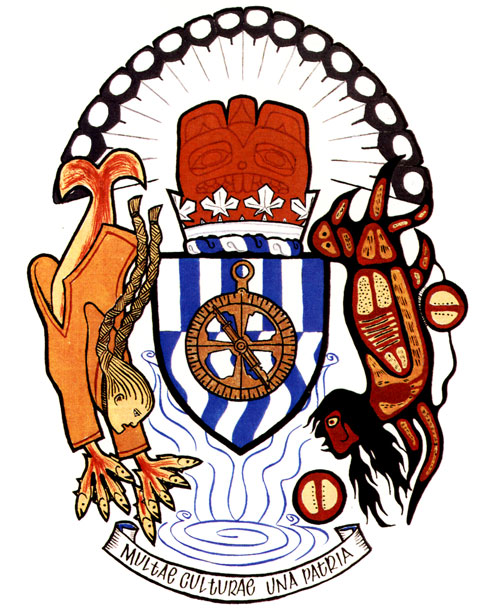Canadian Museum of History
| Heraldry of the World |
| Canada heraldry portal Civic heraldry of Canada Armorial Canadienne |
|
CANADIAN MUSEUM OF HISTORY
Official blazon
Arms : Per fess paly Argent and Azure and paly wavy counterchanged, overall an astrolabe Or
Crest : Issuant from a coronet erablé Argent, a copper of a beaver head in the Haida style environed by a panache of eagle feathers proper
Supporters : Dexter the figure of Sedna, sinister the figure of Asticou, both diving into a whirlpool proper
Motto: MULTÆ CULTURÆ UNA PATRIA
Origin/meaning
The arms were officially granted on April 20, 2017. Originally recorded in the name of the Canadian Museum of Civilization on 29 June 1989.
The vertical lines evoke the Chaudières Falls, which French explorer Samuel de Champlain described in 1613 during his travel up the Ottawa River, nearby the current site of the Canadian Museum of History. The water symbolizes the country’s natural resources in addition to recalling the importance of waterways, for centuries the main trade and communication routes for both the Indigenous peoples and European settlers. The astrolabe, a symbol of European exploration, represents the instrument in the museum’s collection believed to have been lost by Champlain on his journey to the country of the Huron.
A traditional symbol of Canada noted for its industrious skills, the beaver was a major family emblem of Pacific Coast First Nations. This beaver image is taken from a ceremonial copper in the collection of the museum bearing the mark of Chief Ninstints, of the Haida people. The fan of eagle feathers is a traditional symbol of honour of the Plains First Nations. The maple leaf is one of Canada’s national emblems.
On the left, Sedna, the guardian of sea animals in Inuit culture, represents the First Peoples of Canada’s North; she is styled after a work by Inuit artist Manasie Akpaliapik. On the right, Asticou, an Algonquian merman said to live below the Chaudières Falls, represents the First Nations of Eastern Canada; he is styled after a work by Anishinaabe artist Norval Morrisseau. Both spirits are depicted diving into a whirlpool, which represents the power of nature in its elemental state.
The motto means “Many cultures one country”, and recalls the museum’s mandate to preserve and promote the cultural traditions which define Canadians.
Contact and Support
Partners:
Your logo here ?
Contact us
© since 1995, Heraldry of the World, Ralf Hartemink 
Index of the siteLiterature: Image and information from http://www.gg.ca












